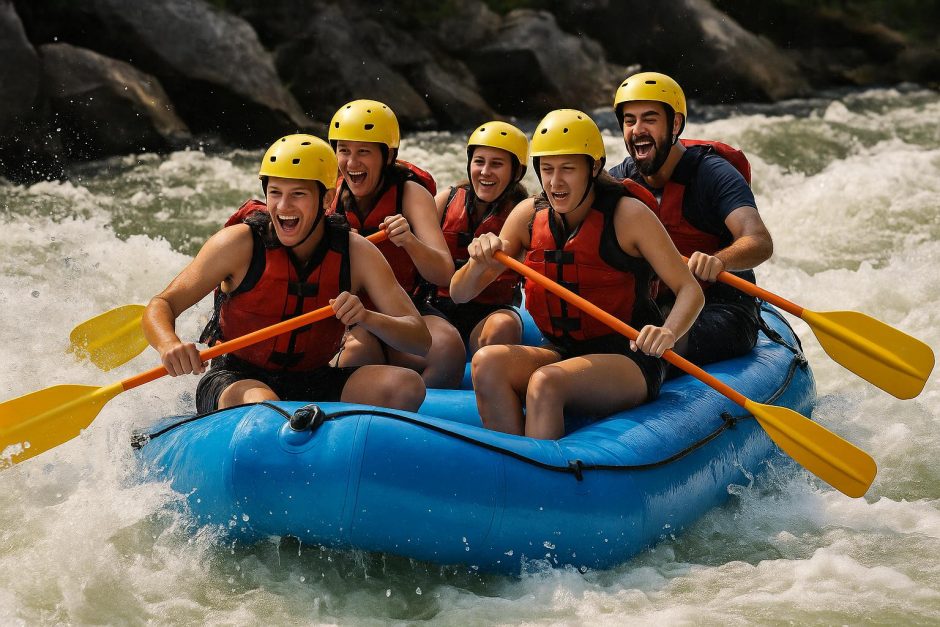Introduction to Whitewater Rafting
Whitewater rafting is an outdoor recreational activity that has surged in popularity over recent years. Participants navigate through river waters within an inflatable raft, usually alongside several companions. The thrilling aspect of whitewater rafting centers on rivers that feature turbulent waters with varying gradients, known as “rapids.” The rapids are famed for their intense, frothy nature, offering both an exhilarating challenge and a compelling opportunity to experience nature from a close vantage point. This unique blend of adventure and natural beauty lies at the heart of why whitewater rafting continues to captivate individuals who venture into the realm of outdoor pursuits.
Understanding Rapids and Their Classifications
The core of whitewater rafting is the interaction with rapids, tumultuous sections of a river defined by high energy and movement. The classification of these rapids is based on their level of difficulty and their potential danger, forming an essential guide for rafters in choosing rivers appropriate to their skill level. The International Scale of River Difficulty is instrumental in categorizing these rapids, spanning from Class I to Class VI:
Class I: The gentlest form of rapids, characterized by negligible waves and minimal risk factors, making them ideal for beginners. They offer a taste of the rafting experience without the intimidating presence of harsh elements.
Class II: These rapids introduce moderate difficulty, presenting larger waves but maintaining easily identifiable passages. While accessible for beginners, Class II rapids may require some degree of paddling skill and basic maneuvering techniques to navigate safely.
Class III: Requiring intermediate skills, these rapids are replete with irregular, stronger waves and may also present obstacles. Successful navigation demands precise maneuvering, calling for a moderate level of rafting experience and knowledge in river reading.
Class IV: These advanced rapids present powerful waves and potential hazards. Rafters must possess strong paddling skills, quick reflexes, and the ability to handle technical maneuvers.
Class V: Reserved for experts, these rapids are notoriously long, violent, and filled with challenging hazards. A deep understanding of river dynamics, advanced navigation skills, and an ability to make quick decisions are essential to tackle Class V rapids.
Class VI: Potentially unrunnable, these rapids are exceptionally dangerous. They may only be attempted by highly skilled and experienced rafting professionals willing to undertake significant risks.
Understanding this classification system is crucial for ensuring the safety of participants, while also maximizing enjoyment when engaging in whitewater rafting.
Equipment Necessary for Whitewater Rafting
Embarking on a whitewater rafting adventure requires proper equipment, crucial for ensuring safety and enhancing the overall experience. The following gear items are deemed essential:
Personal Flotation Device (PFD): This gear provides essential buoyancy, a critical factor in ensuring the safety of all rafters, regardless of swimming ability.
Helmet: Protecting against potential head injuries is paramount in scenarios of sudden impacts or capsizes, underlining the importance of a proper helmet.
Paddle: As a fundamental tool, the paddle allows for navigation and control within the raft, demanding synchronization and teamwork among participants for effective maneuvering.
Wetsuit or Dry Suit: These suits offer thermal protection, particularly important in cold water conditions, by preserving body heat and shielding against rapid temperature changes.
Footwear: Appropriate secure, non-slip shoes are highly recommended to prevent injuries and ensure safety while in and around the water. Footwear that withstands wet conditions is preferable for maintaining grip on slippery surfaces.
Equipping oneself with these essentials is a key element of preparation when setting out on a whitewater rafting journey, reinforcing both safety and comfort.
Popular Whitewater Rafting Destinations
The allure of whitewater rafting draws enthusiasts to some of the most scenic and challenging river areas across the globe. Many famous locations offer unique characteristics and distinctive challenges, beckoning adventurers worldwide. Here are a few of the globally recognized whitewater rafting destinations:
1. Kaituna River, New Zealand – This river is illustrious for its dramatic waterfalls, including the world’s highest commercially rafted waterfall, and its lush surrounding landscape, making it a favored destination for thrill-seekers.
2. Colorado River, USA – Renowned for its varied rapids, the Colorado River provides a blend of tumultuous whitewater sections alongside its breathtaking canyon views, offering a diverse rafting experience.
3. Zambezi River, Zambia/Zimbabwe – As a high-volume river located below the mighty Victoria Falls, the Zambezi presents bold and forceful rapids, providing an exhilarating challenge for even seasoned rafters.
4. Trisuli River, Nepal – This river combines exciting rapids with the scenic backdrop of the Nepali landscape, offering an enthralling mix of adventure and cultural immersion.
These destinations, among many others, signify the widespread appeal of whitewater rafting as a staple activity for adventure tourists, highlighting the value of experiencing nature’s unbridled power and majesty through active engagement.
Conclusion
Whitewater rafting presents a unique pathway to engage with natural water environments while embracing the challenges set by turbulent river conditions. With the right preparations, a sound understanding of rapid classifications, and appropriate equipment, adventurers can undertake a safe and thrilling rafting expedition. Whether navigating through the formidable waters of the Zambezi River or exploring the majestic canyons aligned with the Colorado River, whitewater rafting continues to captivate and inspire outdoor enthusiasts from around the world, providing an unparalleled blend of excitement, challenge, and direct communion with the natural world.

